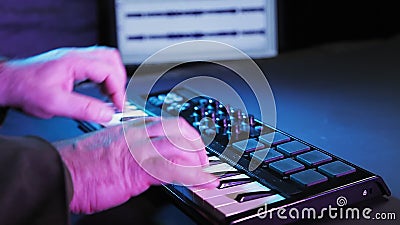


Tapping elsewhere on the navigator keyboard will jump the display to that area. The yellow rectangle indicates the area currently displayed. The small keyboard above the larger one is a Navigator, allowing you to move the area of the keyboard displayed and also resize it. The keyboard itself labels the start of each new octave - C4 and C5 can be seen on the screenshot above.There are, as can be seen, other things available here so we shall now quickly run through some features of the interface shown. Please note though, that while the Modulation Wheel and Pitch Bend Wheel actions will be recorded as part of the MIDI clip information, changes to other synth parameters made while recording will not create automation clips as is about to be described for the instrument parameters of soundfont/SFZ instruments. It has its own playback transport controls though so you can still record using its keyboard, just as when using the keyboard shown in the screenshot above. The Evolution One Synthesizer screen includes its own onscreen virtual keyboard, so if you select that as an instrument, you will see that interface instead.

If you want to hear a metronome as you play (with or without a count-in) you can activate and deactivate it in the Tempo Settings. All of the notes (MIDI events) you play will be recorded to a MIDI clip on the track. Both options also arm the track, lighting up the Arm button in red as can be seen in the screenshot, making it ready to recorded to.įrom this screen, it is simply a case of pressing the Record button and playing the onscreen keyboard as you would a real one.

Now, you can open the virtual onscreen piano keyboard, seen below, by pressing either the Open Virtual Keyboard button or the Arm button, both found on the track's Channel Strip. For driving external MIDI equipment, you need to create a plain (USB) MIDI track instead. Recording MIDI with the onscreen keyboard allows you to live-record MIDI wherever you are and without connecting any external equipment or drive external MIDI equipment when you don't have a physical MIDI keyboard available.įor the first and most common case, create your MIDI Instrument Track using the Add Track button on the Arranger Screen and select your virtual instrument as described here. Recording MIDI with the Onscreen Piano Keyboard You can either use the virtual instruments that you can select in the app (Soundfonts or the Evolution One synth) to produce audio on your device or drive external MIDI equipment like synthesizers connected by USB MIDI. MIDI compositions can be created manually using the Piano Roll Editor or the Drum Pattern Sequencer, but it is also possible to live record your MIDI information using the onscreen keyboard, the onscreen drum pads, a connected external MIDI keyboard or other external MIDI equipment.


 0 kommentar(er)
0 kommentar(er)
